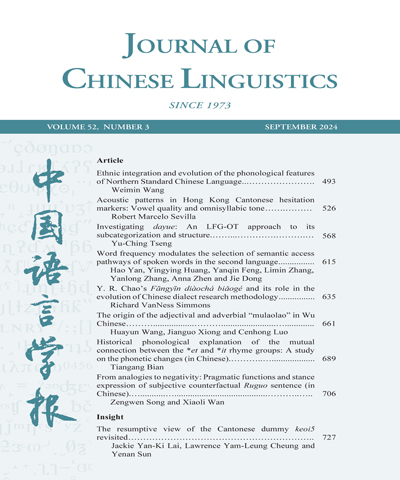
Journal of Chinese Linguistics/中國語言學報
Journal of Chinese Linguistics Publication Office,正常發行
選擇卷期
- 期刊
The present paper investigates Mandarin verbs of MOTION, one of the fundamental domains of human activities and extensively discussed areas in linguistic research. Previous studies on Mandarin motion verbs are done primarily with a typological concern. However, given the iconic nature of serial motions in Mandarin, this paper attempts to provide a systematic and comprehensive analysis of the semantic-to-morphological and lexical-to-grammatical distinctions pertaining to the colloconstructional sequencing of motion verbs. Based on the Proto-Motion Event Schema (PMS), it offers an overarching framework for a top-down analysis of the conceptual structure of motion and a bottom-up examination of corpus-based collocations. Representing the iconic sequence of serial motion events, the Schema helps to identify the crucial semantic components, both verb-internally and verb-externally, for a systematic investigation and classification of motion progression. It attempts to establish a link for lexical semantic studies of motion from various perspectives. By probing into the conceptual basis of proto-motion event, the study ultimately offers an iconically-motivated account of the possible ranges of verb meaning and the semantic-to-morphosyntactic sequencing of Mandarin motion verbs.
- 期刊
In contact linguistics, an overlooked area that has immense research potential is regular semantic change exhibited by loanwords. Due to the relatively shorter histories of contact languages as compared to 'normal' languages, semantic changes in contact languages are far better understood, thereby presenting us with case studies of polysemous words where contact-induced change and regular semantic change can be better demarcated. Studying such phenomena will thus shed light on the cognitive processes behind semantic change. This paper looks at how language use shapes the semantic pathway of Singapore Southern Min loanword balu and suggests that the findings in this paper can be applied cross-linguistically to other cases of regular semantic change. Singapore Colloquial Malay adverb baru 'recently' was borrowed into Singapore Southern Min as balu 'recently'. Although Southern Min balu and Malay baru both share a common function, they exhibit disparate semantic pathways. Data gathered shows that loanword balu 'recently' has no tendency to develop a conjunctive function similar to that of Singapore Colloquial Malay and baru 'recently' has no tendency to develop another adverbial function like that of balu 'recently' in Singapore Southern Min. Initial findings of this paper suggest that the contrasting semantic pathways for Southern Min balu 'recently' and Malay baru 'recently' are due to differences in semantic fields a particular word is most strongly associated. Nevertheless, the overarching mechanism behind both semantic changes is still pragmatic inferencing, or in other words, a reanalysis of contextually ambiguous sentences.
- 期刊
“纸张粉碎机”等汉语含动复合词的生成不只是句法操作或词法操作的结果,“碎纸机”合法,但“ *粉碎纸张机”不合法:”纸张粉碎机”合法,但“ *纸碎机”不合法,这说明韵律因素在这类词的生成过程中起着重要作用。近年来,关于韵律因素如何影响含动复合词生成的研究已经取得了很多成果,但随着研究的深入及对语料的更深入挖掘,前人研究中存在的一些不足逐渐显现。这篇文章首先详细分析了前人研究的不足,然后提出了影响汉语含动复合词生成的两个韵律限制:动词音步相邻、自然音步限制。基于这两个限制,可以有效地解释韵律对含动复合词生成的影响。
- 期刊
Based on firsthand acoustic data, this paper aims to determine how many phonologically contrastive falling tones exist in tonal languages, and what kinds of distinctive features are needed to specify them. These goals are achieved by using a tonal model called the Multi-Register and Four-Level Model, which represents tones along four parameters: register, length, height, and contour. Having excluded a quasi-falling tone, this paper identifies seven Falling Tonotypes in the M Register: High, Low, MS-High, MS-Low, Deferred-High, Deferred-Low, and Slight Falling. Four of these also occur in the L Register with special voice qualities. In total, there are eleven Falling Tonotypes, which can be specified according to five distinctive features.
- 期刊
DEVOICING OF HISTORICALLY VOICED OBSTRUENTS IN XIANGXIANG CHINESE - AN ACOUSTIC-PHONETIC PERSPECTIVE
In this paper the present-day pronunciations of the historically voiced obstruents in Xiangxiang Chinese were examined from an acoustic-phonetic perspective. Results strongly supported an ongoing process of devoicing for the voiced stops, fricatives and affricates, which is conditioned by a couple of factors including sex of speaker, place of articulation, manner of articulation and historically tonal type. Specifically, historically voiced obstruents in syllables corresponding to the historical tone category Ru have all become voiceless unaspirated or voiceless aspirated, meaning the process of devoicing has already completed; in contrast, for those that occur in syllables corresponding to the other three tonal categories, i.e., Ping, Shang, and Qu, i) the historical devoicing is still in progress, as evidenced by a considerable amount of intra- and inter-speaker free variation in the pattern of voicing among "fully voiced", "partially devoiced" and "fully devoiced" obstruents; ii) the degree of devoicing is the highest in voiced fricatives, followed by the voiced affricates, and is the lowest in voiced stops; and iii) the devoicing also tends to be more extensive for obstruents with a more posterior place of articulation, and for male than female speakers. Candidate explanations for these patterns of devoicing were also presented.
- 期刊
事态助词"了_2"在南北官话里发育成熟的时间不同:北方在明代,南方在南宋。南北官话的"了_2"各有不同的演变路径,南方的"了_2"来源于"动(+宾)+了"中的动相补语"了";北方的"了_2"由动态助词"了1"语法化而来。
- 期刊
Recent cross-language research has yielded strong statistical evidence in support of the idea, advocated by André Martinet and widely accepted by linguists, that languages avoid adopting sound-changes which would create many homophones. Yet we know that the history of Chinese phonology has been marked by repeated phoneme mergers and losses which led to a very high incidence of homophony, forcing the monomorphemic vocabulary of the classical language to be replaced by a largely bimorphemic modern vocabulary. This paper examines various ways in which this apparent contradiction might be resolved. None seems fully satisfactory, yet some resolution must exist.

